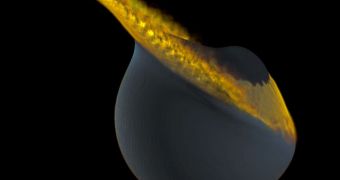According to the conclusions of a study published in the August 4 issue of the top scientific journal Nature, it would appear that our planet had two moons when it first formed. These objects then collided with each other to form the Moon as we know it now, the team behind the research argues.
The second moon would have been relatively small, and may have continued to orbit Earth for a while, before finally slamming into its larger companion. Researchers say that this may help explain why the two sides of the lunar surface are so different from each other, when theory cannot explain this.
When the solar system was still in its earliest days, Earth had a massive collision with a Mars-sized celestial object. The event was so catastrophic that a huge amount of material was ejected into orbit.
This is the widely-accepted view of how the Moon formed. What the study is proposing is that the impact also produced a second, 750-mile (1,200-kilometer) wide body. If that is true, then Earth's second moon was larger than many moons around other planets in the solar system today.
When the Soviet Luna 3 spacecraft first imaged the far side of the Moon, back in 1959, it revealed an amazing landscape that was very different from the one visible on the near side of the natural satellite.
One of the most important differences is the number of volcanic rock plains called maria. The near side is literally covered with them, whereas the far side exhibits only a few such landscape features.
The far side is also very high and mountainous, and nearly completely devoid of the low and flat terrain that characterizes the near side of the Moon. On average, the far side is 1.2 miles (1.9 kilometers) higher in altitude than its counterpart.
According to the new investigation, the differences between the two sides of the Moon can only be explained if astronomers accept that a second Moon flattened itself against its companion. This goes a long way towards explaining why the far side looks the way it does today.
“It is entirely plausible for a Trojan moon to have formed in the giant impact, and for it to go unstable after 10 million to 100 million years and leave its imprint on the moon [like] a ball of Gruyere colliding into a ball of cheddar,” says Erik Asphaug, quoted by Space.
The expert – a coauthor of the new study – holds an appointment as a planetary scientist at the University of California in Santa Cruz (UCSC). He adds that the collision may have taken place at a speed of about 4,500 to 6,700 miles (7,200 to 10,800 kilometers) per hour.
Rather than forming a large crater, the second moon would have disintegrated itself, splattering an added layer of material on the hard surface of the first moon. This may account for the mean altitude difference between the two sides of the Moon.
The idea is bound to generate a lot of controversy, so keep an eye on this space for more details.

 14 DAY TRIAL //
14 DAY TRIAL //